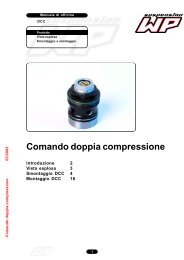Understanding ECU Remapping: The Audi TT 1.8 T - contiman - Free
Understanding ECU Remapping: The Audi TT 1.8 T - contiman - Free
Understanding ECU Remapping: The Audi TT 1.8 T - contiman - Free
Create successful ePaper yourself
Turn your PDF publications into a flip-book with our unique Google optimized e-Paper software.
<strong>Understanding</strong> <strong>ECU</strong> <strong>Remapping</strong>: <strong>The</strong> <strong>Audi</strong> <strong>TT</strong> <strong>1.8</strong>T Variants/Bosch Motronic ME7.x<br />
retard timing and run richer mixtures to safeguard against deviations in the vehicle’s maintenance regime or<br />
pre-ignition and knock caused by low octane fuel.<br />
A basic appreciation of the combustion process is useful to underpin understanding the remapping process.<br />
In a simple model of the four-stroke Otto cycle, the fuel-air mixture is always ignited at piston TDC at full<br />
compression. In reality, this is not the case and there is actually a great deal of scope for varying when the<br />
fuel/air mixture is ignited. Ignition is timed to occur several ‘degrees crank’ before TDC (BTDC) for two<br />
reasons:<br />
1. Although the engine can speed up, the fuel-air mix takes a finite amount of time to combust, so at higher<br />
speeds, the mixture needs to be ignited earlier in the cycle so that peak cylinder pressure is achieved at the<br />
optimum crank angle (a few degrees after TDC).<br />
2. To try to lengthen the combustion process to obtain a more controlled burn because the burn rate is<br />
influenced by various conditions such as AFR and temperature. I.e., a richer mixture is heavier so will burn<br />
more slowly. Similarly, the mixture will be denser at lower ambient temperatures and will also burn more<br />
slowly requiring greater ignition advance to achieve peak cylinder pressure at the optimum point in the cycle.<br />
SSP 322 (<strong>The</strong> 2.0l FSI Engine with 4-Valve Technology) illustrates just how much scope there is for varying<br />
these parameters in the context of lean-burn strategies.<br />
In the ‘stratified charge mode’, a layer of insulating air is created between the ignited mixture and the cylinder<br />
wall which reduces the amount of heat transferred via the engine block and thus improves efficiency.<br />
Contrast this with the ‘homogeneous mode’ in which fuel is injected during the intake stroke (0-180 °crank)<br />
and not in the compression phase (180-360 °crank). <strong>The</strong> fuel-air mixture has more time to mix thoroughly<br />
before ignition and fuel evaporation removes some of the heat from the incoming air. Cooling the combustion<br />
chamber reduces the tendency to knock and thus increases the engine compression and efficiency.<br />
Contrast this with the turbocharged version of the 2.0 litre FSI engine described in SSP 337. <strong>The</strong> stratified<br />
combustion mode has been designed out and the piston head design (shown in Figure S337_011) is very<br />
different.<br />
Table 2.1. Some ‘rule-of-thumb’ AFR/lambda limits<br />
AFR lambda Notes<br />
6.0:1 0.41 Rich run limit<br />
9.0:1 0.61 Low power, black smoke<br />
11.5:1 0.78 Rich best torque at WOT<br />
12.5:1 0.85 Safe best power at WOT<br />
13.2:1 0.90 Lean best torque at WOT<br />
14.7:1 1.00 Stoichiometry (ideal)<br />
15.5:1 1.05 Lean light load, part throttle<br />
16.2:1 1.10 Best economy, part throttle<br />
18-22:1 1.22-1.50 Lean run limit<br />
In general, a lower rate of change of energy transfer from the gas explosion to the piston head enables more<br />
useful work to be done. Higher octane fuels are preferred for tuned cars because they have a larger<br />
proportion of branched chain hydrocarbons. <strong>The</strong>se burn cooler and more slowly than molecules with fewer<br />
branches which makes them less prone to pre-ignition and knock. Pre-ignition is the tendency for the fuel to<br />
ignite before the spark event whereas knock is explosive combustion after the spark event. <strong>The</strong>se<br />
phenomena result in three extremely undesirable effects: (a) a rapid, uncontrolled increase in cylinder<br />
pressure (b) greater than desired peak cylinder pressure and (c) peak cylinder pressure achieved at the<br />
wrong time in the cycle. It should be obvious enough why an opposing downward force being applied when<br />
the cylinder traveling up towards TDC is a bad thing. As a rule of thumb, the maximum tolerable cylinder<br />
overpressure (in bar) is RPM/1000. I.e. 4 bar at 4,000 RPM. This is only useful to OEM calibrators who can<br />
measure the cylinder pressure during the initial tuning process with pressure transducers fitted to speciallymodified<br />
cylinder heads or incorporated into the spark plugs.<br />
3. How Bosch Motronic ME7.x Works in the Context of the <strong>Audi</strong> <strong>TT</strong> 8N<br />
<strong>The</strong> Motronic electronic control unit (<strong>ECU</strong>) consists of a sixteen bit Siemens C167 microprocessor and a<br />
memory. Each 16 bit word contains an executable instruction or a piece of data in binary format. <strong>The</strong><br />
memory contains a work program with algorithms and data for determining all the primary outputs such as<br />
4



